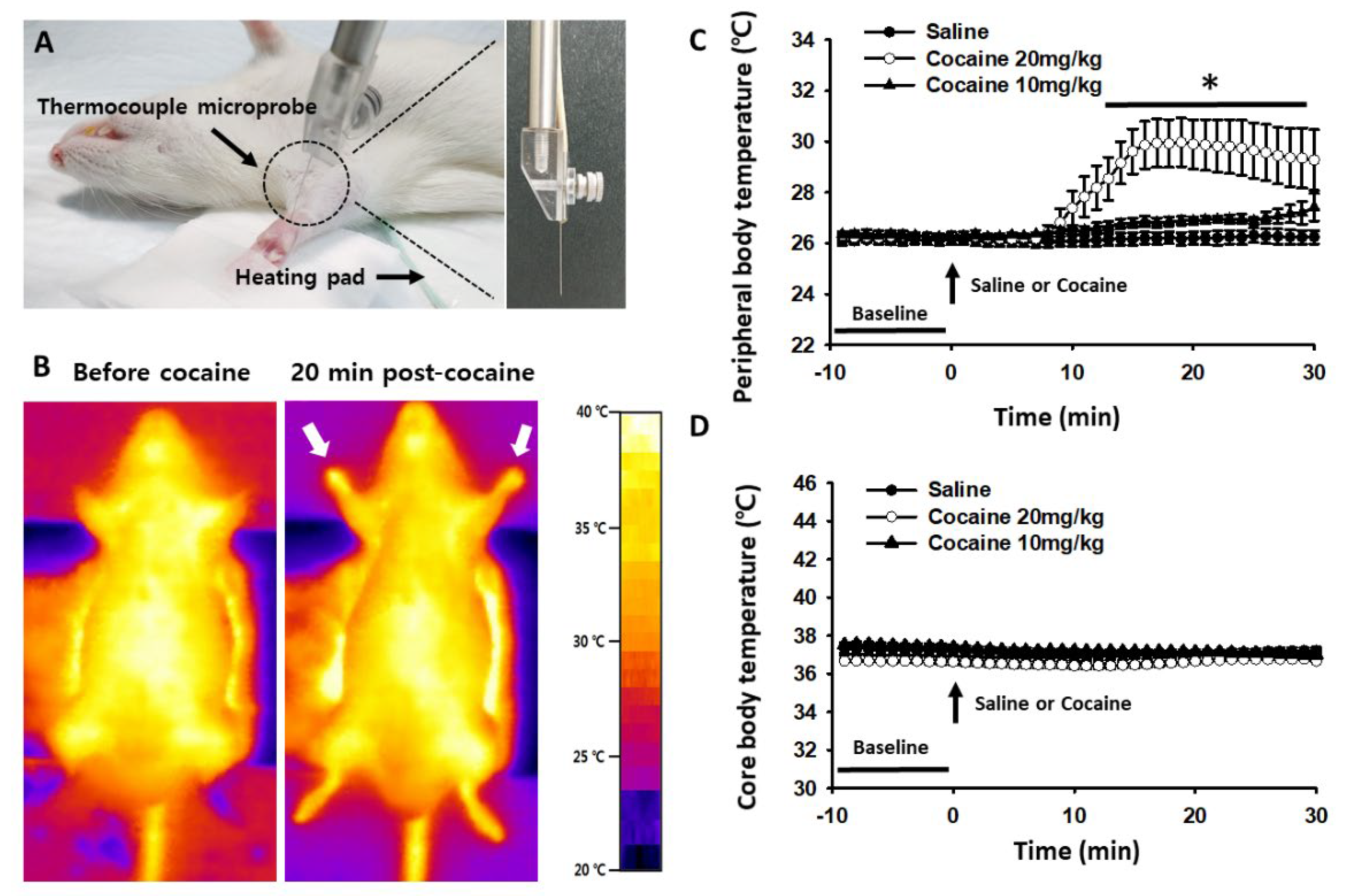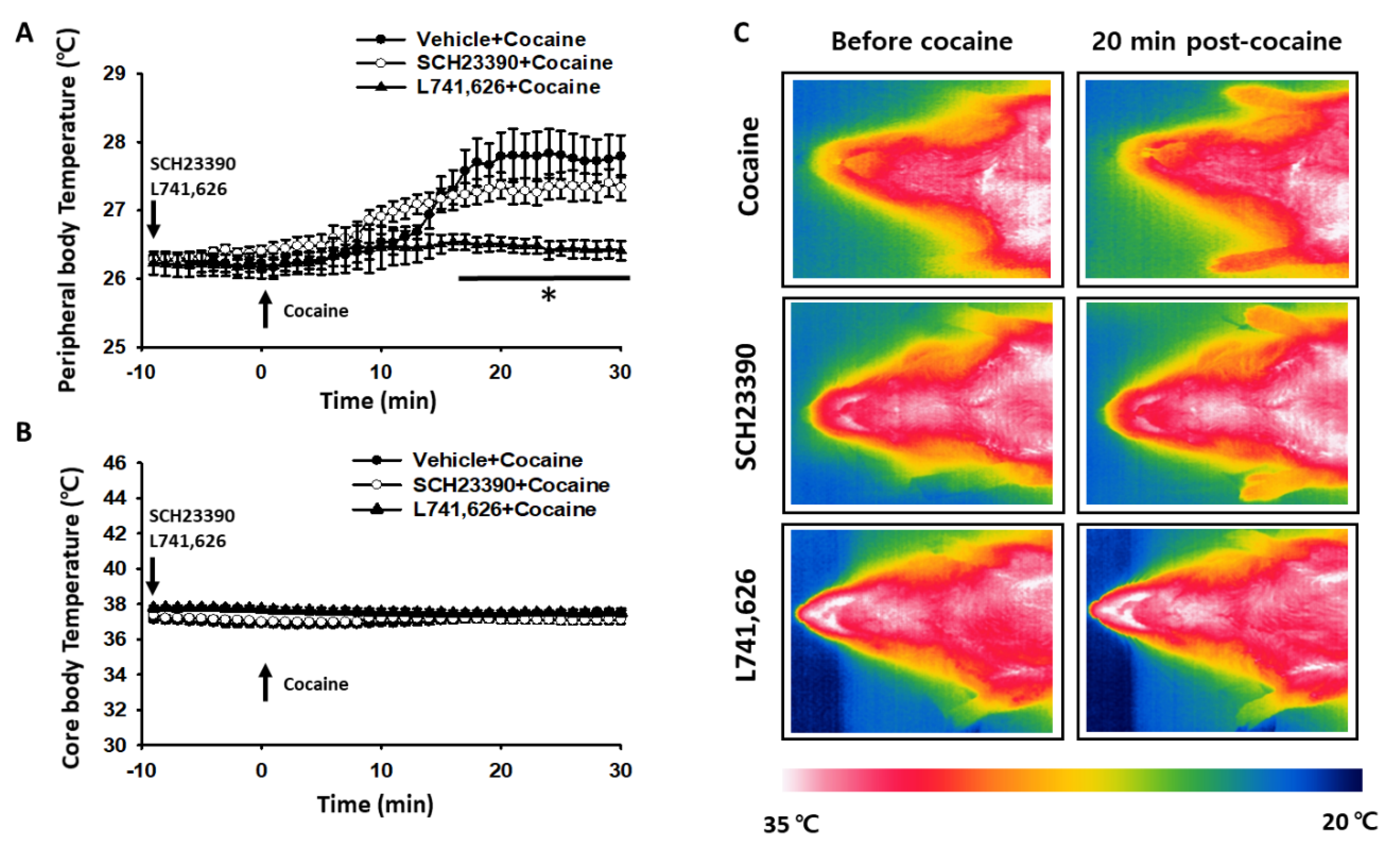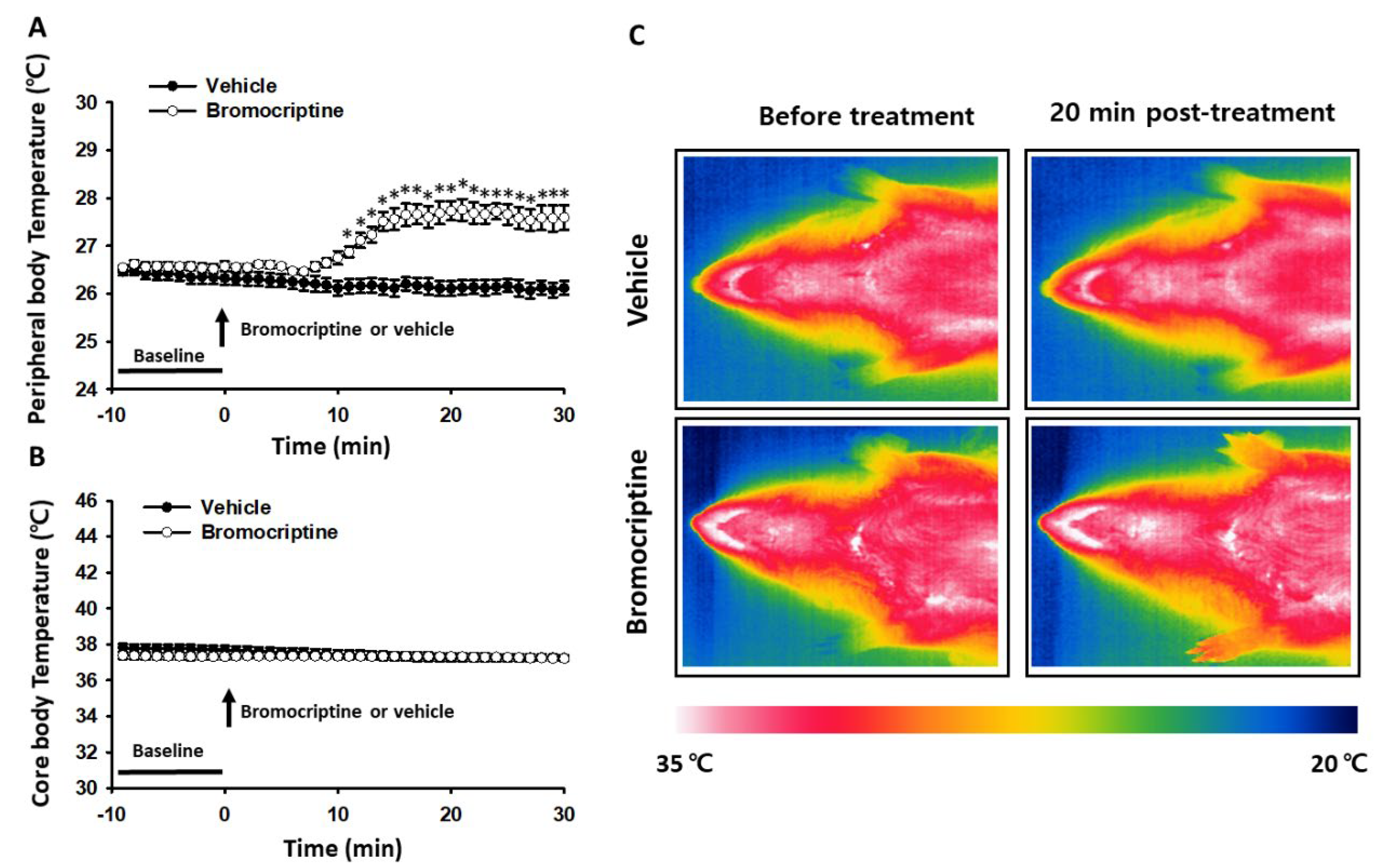An Increase in Peripheral Temperature following Cocaine Administration Is Mediated through Activation of Dopamine D2 Receptor in Rats
Abstract
1. Introduction
2. Materials and Methods
2.1. Animals
2.2. Chemicals
2.3. Measurement of Peripheral Body and Core Body Temperatures
2.4. Immunohistochemistry for Dopamine D2 Receptor
2.5. Histological Assessment of Skin Blood Vessels
2.6. Statistical Analysis
3. Results
3.1. An Increase in Peripheral Body Temperature following Cocaine Injection
3.2. Involvement of Dopamine Receptors in Cocaine-Induced Elevation of Peripheral Skin Temperature
3.3. Increase in Peripheral Body Temperature by Dopamine D2 Receptor Agonist
3.4. Histological Measurement and Dopamine D2 Receptor Expression on Peripheral Skin Area
4. Discussion
Author Contributions
Funding
Institutional Review Board Statement
Informed Consent Statement
Data Availability Statement
Conflicts of Interest
References
- Canton, H. United Nations Office on Drugs and Crime—UNODC. In The Europa Directory of International Organizations; Routledge: London, UK, 2021; pp. 240–244. [Google Scholar]
- Ali, S.F.; S Onaivi, E.; R Dodd, P.; L Cadet, J.; Schenk, S.; J Kuhar, M.; F Koob, G. Understanding the global problem of drug addiction is a challenge for IDARS scientists. Curr. Neuropharmacol. 2011, 9, 2–7. [Google Scholar] [CrossRef]
- Huang, X.; Gu, H.H.; Zhan, C.-G. Mechanism for cocaine blocking the transport of dopamine: Insights from molecular modeling and dynamics simulations. J. Phys. Chem. B 2009, 113, 15057–15066. [Google Scholar] [CrossRef] [PubMed]
- Adinoff, B. Neurobiologic processes in drug reward and addiction. Harv. Rev. Psychiatry 2004, 12, 305–320. [Google Scholar] [CrossRef] [PubMed]
- Yoon, J.H.; Shah, R.S.; Arnoudse, N.M.; De La Garza, R. Remote physiological monitoring of acute cocaine exposure. J. Med. Eng. Technol. 2014, 38, 244–250. [Google Scholar] [CrossRef]
- Vroegop, M.; Franssen, E.; Van der Voort, P.; Van den Berg, T.; Langeweg, R.; Kramers, C. The emergency care of cocaine intoxications. Neth. J. Med. 2009, 67, 122–126. [Google Scholar] [PubMed]
- Schwartz, B.G.; Rezkalla, S.; Kloner, R.A. Cardiovascular effects of cocaine. Circulation 2010, 122, 2558–2569. [Google Scholar] [CrossRef]
- Vongpatanasin, W.; Mansour, Y.; Chavoshan, B.; Arbique, D.; Victor, R.G. Cocaine stimulates the human cardiovascular system via a central mechanism of action. Circulation 1999, 100, 497–502. [Google Scholar] [CrossRef] [PubMed]
- Egashira, K.; Morgan, K.G.; Morgan, J.P. Effects of cocaine on excitation-contraction coupling of aortic smooth muscle from the ferret. J. Clin. Investig. 1991, 87, 1322–1328. [Google Scholar] [CrossRef][Green Version]
- Gurudevan, S.V.; Nelson, M.D.; Rader, F.; Tang, X.; Lewis, J.; Johannes, J.; Belcik, J.T.; Elashoff, R.M.; Lindner, J.R.; Victor, R.G. Cocaine-induced vasoconstriction in the human coronary microcirculation: New evidence from myocardial contrast echocardiography. Circulation 2013, 128, 598–604. [Google Scholar] [CrossRef][Green Version]
- Lange, R.A.; Cigarroa, R.G.; Yancy, C.W., Jr.; Willard, J.E.; Popma, J.J.; Sills, M.N.; McBride, W.; Kim, A.S.; Hillis, L.D. Cocaine-induced coronary-artery vasoconstriction. N. Engl. J. Med. 1989, 321, 1557–1562. [Google Scholar] [CrossRef]
- Wise, R.A.; Kiyatkin, E.A. Differentiating the rapid actions of cocaine. Nat. Rev. Neurosci. 2011, 12, 479–484. [Google Scholar] [CrossRef] [PubMed]
- Raiker, N.; Aouthmany, M.N.E. Dermatologic Signs and Symptoms of Substance Abuse. J. Clin. Exp. Dermatol. Res. 2016, 7, 1000337. [Google Scholar] [CrossRef]
- Liu, S.W.; Lien, M.H.; Fenske, N.A. The effects of alcohol and drug abuse on the skin. Clin. Dermatol. 2010, 28, 391–399. [Google Scholar] [CrossRef] [PubMed]
- Marui, S.; Uchida, Y.; Nagashima, K. Daily changes of body temperature and heart rate are modulated after estradiol depletion in female rats. Anat Physiol. 2016, 6, 2161. [Google Scholar] [CrossRef]
- Aoyama, K.; Barnes, J.; Koerber, J.; Glueck, E.; Dorsey, K.; Eaton, L.; Grimm, J.W. Systemic injection of the DAD1 antagonist SCH 23390 reduces saccharin seeking in rats. Appetite 2016, 105, 8–13. [Google Scholar] [CrossRef] [PubMed]
- Lewitus, G.M.; Konefal, S.C.; Greenhalgh, A.D.; Pribiag, H.; Augereau, K.; Stellwagen, D. Microglial TNF-α suppresses cocaine-induced plasticity and behavioral sensitization. Neuron 2016, 90, 483–491. [Google Scholar] [CrossRef] [PubMed]
- Robertson, G.S.; Robertson, H.A. Synergistic effects of D1 and D2 dopamine agonists on turning behaviour in rats. Brain Res. 1986, 384, 387–390. [Google Scholar] [CrossRef]
- Farooqui, S.M.; Prasad, C.; Ali, M. Production and characterization of a monoclonal antibody to dopamine D2 receptor: Comparison with a polyclonal antibody to a different epitope. Biochem. Biophys. Res. Commun. 1992, 184, 661–667. [Google Scholar] [CrossRef]
- Stojanovic, T.; Orlova, M.; Sialana, F.J.; Höger, H.; Stuchlik, S.; Milenkovic, I.; Aradska, J.; Lubec, G. Validation of dopamine receptor DRD1 and DRD2 antibodies using receptor deficient mice. Amino Acids 2017, 49, 1101. [Google Scholar] [CrossRef]
- Clare, K.; Pan, C.; Kim, G.; Park, K.; Zhao, J.; Volkow, N.D.; Lin, Z.; Du, C. Cocaine Reduces the Neuronal Population While Upregulating Dopamine D2-Receptor-Expressing Neurons in Brain Reward Regions: Sex-Effects. Front. Pharmacol. 2021, 12, 347. [Google Scholar] [CrossRef] [PubMed]
- Navarro, G.; Moreno, E.; Bonaventura, J.; Brugarolas, M.; Farre, D.; Aguinaga, D.; Mallol, J.; Cortes, A.; Casado, V.; Lluís, C. Cocaine inhibits dopamine D2 receptor signaling via sigma-1-D2 receptor heteromers. PLoS ONE 2013, 8, e61245. [Google Scholar] [CrossRef]
- Sullivan, J.T.; Becker, P.M.; Preston, K.L.; Wise, R.A.; Wigely, F.M.; Testa, M.P.; Jasinski, D.R. Cocaine effects on digital blood flow and diffusing capacity for carbon monoxide among chronic cocaine users. Am. J. Med. 1997, 102, 232–238. [Google Scholar] [CrossRef]
- Millan, M.J.; Maiofiss, L.; Cussac, D.; Audinot, V.; Boutin, J.-A.; Newman-Tancredi, A. Differential actions of antiparkinson agents at multiple classes of monoaminergic receptor. I. A multivariate analysis of the binding profiles of 14 drugs at 21 native and cloned human receptor subtypes. J. Pharmacol. Exp. Ther. 2002, 303, 791–804. [Google Scholar] [CrossRef]
- Newman-Tancredi, A.; Cussac, D.; Audinot, V.; Nicolas, J.-P.; De Ceuninck, F.; Boutin, J.-A.; Millan, M.J. Differential actions of antiparkinson agents at multiple classes of monoaminergic receptor. II. Agonist and antagonist properties at subtypes of dopamine D2-like receptor and α1/α2-adrenoceptor. J. Pharmacol. Exp. Ther. 2002, 303, 805–814. [Google Scholar] [CrossRef]
- Newman-Tancredi, A.; Cussac, D.; Quentric, Y.; Touzard, M.; Verrièle, L.; Carpentier, N.; Millan, M.J. Differential actions of antiparkinson agents at multiple classes of monoaminergic receptor. III. Agonist and antagonist properties at serotonin, 5-HT1 and 5-HT2, receptor subtypes. J. Pharmacol. Exp. Ther. 2002, 303, 815–822. [Google Scholar] [CrossRef]
- Crandall, C.G.; Vongpatanasin, W.; Victor, R.G. Mechanism of cocaine-induced hyperthermia in humans. Ann. Intern. Med. 2002, 136, 785–791. [Google Scholar] [CrossRef] [PubMed]
- Lomax, P.; Daniel, K.A. Cocaine and body temperature in the rat: Effects of ambient temperature. Pharmacology 1990, 40, 103–109. [Google Scholar] [CrossRef]
- Ferguson, A.; Veale, W.; Cooper, K. Changes in the hypothalamic mechanisms involved in the control of body temperature induced by the early thermal environment. Brain Res. 1984, 290, 297–306. [Google Scholar] [CrossRef]
- Lin, M.; Ho, M.; Young, M. Stimulation of the nigrostriatal dopamine system inhibits both heat production and heat loss mechanisms in rats. Naunyn-Schmiedeberg’s Arch. Pharmacol. 1992, 346, 504–510. [Google Scholar] [CrossRef]
- Lomax, P.; Daniel, K.A. Cocaine and body temperature in the rat: Effect of exercise. Pharmacol. Biochem. Behav. 1990, 36, 889–892. [Google Scholar] [CrossRef]
- Kiyatkin, E.A.; Brown, P.L. Brain and body temperature homeostasis during sodium pentobarbital anesthesia with and without body warming in rats. Physiol. Behav. 2005, 84, 563–570. [Google Scholar] [CrossRef] [PubMed]
- Schmidt, H.D.; Pierce, R.C. Cocaine-induced neuroadaptations in glutamate transmission: Potential therapeutic targets for craving and addiction. Ann. N. Y. Acad. Sci. 2010, 1187, 35. [Google Scholar] [CrossRef] [PubMed]
- Nestler, E.J. The neurobiology of cocaine addiction. Sci. Pract. Perspect. 2005, 3, 4. [Google Scholar] [CrossRef] [PubMed]
- Vaughn, A.R.; Davis, M.J.; Sivamani, R.K.; Isseroff, R.R. A Concise Review of the Conflicting Roles of Dopamine-1 versus Dopamine-2 Receptors in Wound Healing. Molecules 2017, 23, 50. [Google Scholar] [CrossRef]
- Tammaro, A.; Cavallotti, C.; Gaspari, A.A.; Narcisi, A.; Parisella, F.R.; Cavallotti, C. Dopaminergic receptors in the human skin. J. Biol. Regul. Homeost. Agents 2012, 26, 789–795. [Google Scholar] [PubMed]
- Fuziwara, S.; Suzuki, A.; Inoue, K.; Denda, M. Dopamine D2-like receptor agonists accelerate barrier repair and inhibit the epidermal hyperplasia induced by barrier disruption. J. Investig. Dermatol. 2005, 125, 783–789. [Google Scholar] [CrossRef] [PubMed]
- Hasbi, A.; O’Dowd, B.F.; George, S.R. Heteromerization of dopamine D2 receptors with dopamine D1 or D5 receptors generates intracellular calcium signaling by different mechanisms. Curr. Opin. Pharmacol. 2010, 10, 93–99. [Google Scholar] [CrossRef][Green Version]
- Neves, P.C.; Neves, M.C.; Cruz, A.B.; Sant’Ana, A.E.; Yunes, R.A.; Calixto, J.B. Differential effects of Mandevilla velutina compounds on paw oedema induced by phospholipase A2 and phospholipase C. Eur. J. Pharmacol. 1993, 243, 213–219. [Google Scholar] [CrossRef]
- Fulton, D.; McGiff, J.C.; Quilley, J. Role of phospholipase C and phospholipase A2 in the nitric oxide-independent vasodilator effect of bradykinin in the rat perfused heart. J. Pharmacol. Exp. Ther. 1996, 278, 518–526. [Google Scholar]
- Bhattacharyya, S.; Raote, I.; Bhattacharya, A.; Miledi, R.; Panicker, M.M. Activation, internalization, and recycling of the serotonin 2A receptor by dopamine. Proc. Natl. Acad. Sci. USA 2006, 103, 15248–15253. [Google Scholar] [CrossRef]
- Oz, M.; Zhang, L.; Rotondo, A.; Sun, H.; Morales, M. Direct activation by dopamine of recombinant human 5-HT1A receptors: Comparison with human 5-HT2C and 5-HT3 receptors. Synapse 2003, 50, 303–313. [Google Scholar] [CrossRef] [PubMed]
- Haj-Dahmane, S. D2-like dopamine receptor activation excites rat dorsal raphe 5-HT neurons in vitro. Eur. J. Neurosci. 2001, 14, 125–134. [Google Scholar] [CrossRef] [PubMed]
- Sugimoto, Y.; Ohkura, M.; Inoue, K.; Yamada, J. Involvement of the 5-HT2 receptor in hyperthermia induced by p-chloroamphetamine, a serotonin-releasing drug in mice. Eur. J. Pharmacol. 2000, 403, 225–228. [Google Scholar] [CrossRef]
- Blier, P.; Seletti, B.; Gilbert, F.; Young, S.N.; Benkelfat, C. Serotonin 1A receptor activation and hypothermia in humans: Lack of evidence for a presynaptic mediation. Neuropsychopharmacology 2002, 27, 301–308. [Google Scholar] [CrossRef]
- Gudelsky, G.; Koenig, J.; Meltzer, H. Thermoregulatory responses to serotonin (5-HT) receptor stimulation in the rat: Evidence for opposing roles of 5-HT2 and 5-HT1A receptors. Neuropharmacology 1986, 25, 1307–1313. [Google Scholar] [CrossRef]




Publisher’s Note: MDPI stays neutral with regard to jurisdictional claims in published maps and institutional affiliations. |
© 2022 by the authors. Licensee MDPI, Basel, Switzerland. This article is an open access article distributed under the terms and conditions of the Creative Commons Attribution (CC BY) license (https://creativecommons.org/licenses/by/4.0/).
Share and Cite
Chang, S.; Ryu, Y.; Bang, S.K.; Jang, H.B.; Ahn, D.; Kim, H.K.; Lee, H.; Kim, S.C.; Lee, B.H.; Kim, H.Y. An Increase in Peripheral Temperature following Cocaine Administration Is Mediated through Activation of Dopamine D2 Receptor in Rats. Life 2022, 12, 143. https://doi.org/10.3390/life12020143
Chang S, Ryu Y, Bang SK, Jang HB, Ahn D, Kim HK, Lee H, Kim SC, Lee BH, Kim HY. An Increase in Peripheral Temperature following Cocaine Administration Is Mediated through Activation of Dopamine D2 Receptor in Rats. Life. 2022; 12(2):143. https://doi.org/10.3390/life12020143
Chicago/Turabian StyleChang, Suchan, Yeonhee Ryu, Se Kyun Bang, Han Byeol Jang, DanBi Ahn, Hyung Kyu Kim, Hubert Lee, Sang Chan Kim, Bong Hyo Lee, and Hee Young Kim. 2022. "An Increase in Peripheral Temperature following Cocaine Administration Is Mediated through Activation of Dopamine D2 Receptor in Rats" Life 12, no. 2: 143. https://doi.org/10.3390/life12020143
APA StyleChang, S., Ryu, Y., Bang, S. K., Jang, H. B., Ahn, D., Kim, H. K., Lee, H., Kim, S. C., Lee, B. H., & Kim, H. Y. (2022). An Increase in Peripheral Temperature following Cocaine Administration Is Mediated through Activation of Dopamine D2 Receptor in Rats. Life, 12(2), 143. https://doi.org/10.3390/life12020143








